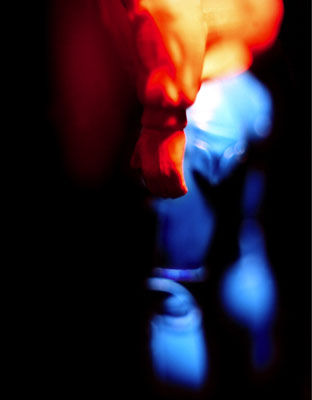KIMBER
Twilight
Every trip to faraway places is inevitably accompanied by the tourist’s reflex; a desire to bring some aspect of the experience home in object form. With souvenirs (from the French for “remembering”) comes the small victory of ownership, but also, incompleteness, in possession of a paltry, mere replica of the original experience. The souvenir recharges the dead time, but only so far. What lingers is inchoate memory, which affirms that no totem will bring back the time it consolidates in material form.
Felicia Feaster, Art Papers, July 1999, page 7
In the half light of twilight his frame would dominate the room. That shape loomed above me, an outline both inspiring and fragile. It took me years to understand that the image of masculinity I saw in him was as much theatrical as it was real. The images here play with that enigma. They balance between my deeply felt desire to believe and participate in the theatre of masculinity that he personified and the inevitable awareness that it was and still remains a trick of the light.
Imitating authority figures is a way of reducing demons to dolls, of shaping an outside world that for the rest of the day, is doing its best to shape us. We learn to speak through imitation of speech. Parody is then a basis from which we begin to shape our identity and parody is best performed in a trance-like state pitched somewhere between attention and instinct. Successful parody lies in the centre of half belief and half disbelief. It must resonate between the two poles of scepticism and gullibility, if either pole topples, the joke caves in.
So in effect the theatre of these images occupy simultaneously the worlds of seduction and cynicism. Without the apparent beauty of the idealised there is little to compel us to commit and perhaps our sense of identity is formed as much by our success at parody as it is with our failure.
The American artist Gregory Crewdson talks about a gap or failure to achieve the ideal.
“…I’m drawn … by some irrational desire to create an image of a perfect world. I strive to create that perfection through obsessive detailing, through a weird kind of realist vision. When the mystery of the photograph emerges, my irrational need to create a perfect world meets up with some kind of failure to do so. This collision between failure and compulsion to make something perfect creates an anxiety that interests me.”[1]
The weight of the machismo postures struck by the subjects in these images and their attendant sense of foreboding is undermined by the use of miniature figures, themselves the stylised simulation of cinema’s prevarications of male mythology.
William Shatner, Captain Kirk of StarTrek, when speaking about his favourite hobby, wildboar hunting with a cross-bow at sunset, said that with dark coming on it was best not to look directly at the target when aiming. It is in one’s peripheral vision that objects are more clearly seen in the gloom. Caught out of the corner of our eye are things sometimes invisible in the glare of direct observation. Almost subliminal but no less cogent.
In the half-light of twilight, these images play with the allegory of masculinity underpinned by a nebulous, though encircling atmosphere of eroticism. But, at the same time in building these dramas from the playthings of childhood they convey all the solidity of a mirage. Fictions as frail as they are coercive.
Mark Kimber 2001






